
Winter weather in the UK can result in Snow and Ice warnings being issued, just as in summer we might see, the relatively new, Extreme Heat warnings. These are all part of the Met Office’s National Severe Weather Warning Service, the NSWWS. You may have seen a Cold Health warning mentioned at the start of 2024.
‘UKHSA and the Met Office have issued an amber Cold-Health Alert (CHA) for the NW England, W.Midlands, E.Midlands, SE England and SW England until 12pm on Friday 12 Jan’
This is a different type of message from the usual UK severe weather warnings. The Weather-Health Alert system is issued by UKHSA, the UK Health Security Agency using information from the Met Office. Additional winter and summer alerts can be issued directed at Health and Social services in England. As they have a familiar setup, using the Yellow/Amber/Red format news media often picks them up to highlight an upcoming cold spell. The alert system has been upgraded recently and now reflects forecast impacts rather than just quantitive temperature thresholds.
"the greatest driver of both heat- and cold-related deaths in the UK is the vulnerability of older adults to extreme temperatures...Secondly, while cold-related health risks will continue, heat-related health risks will increase, potentially substantially." UKHSA Climate Change Ch2
The Met Office is responsible for issuing weather warnings. These warn of potential impacts caused by upcoming severe weather. The NSWWS covers Rain, Thunderstorms, Wind, Snow, Lightning, Ice and Fog and, in summer, Extreme Heat.
“warnings are designed to let people, businesses, emergency responders and governments know what weather is in store and what the impacts of that weather may be. “ Met Office
Usually, they follow the Yellow, Amber and Red matrix which links forecast impacts and likelihood. This way of creating the warning level has been in place since 2011. Fog only uses yellow and amber warnings although in winter there can be a significant hazard of freezing fog.
Met Office weather warnings include a level of impact that the forecast weather is expected to bring and the likelihood of those impacts occurring.
Health and weather is a serious concern. We have the CHA in winter and the HHA, Heat-Health Alerts in summer. Both severe cold and extreme heat cause concerns and need preparations, to prevent illness and reduce excess deaths. The extreme heat of 2022, when the UK saw a new highest temperature of 40.3C, was part of a significant heatwave. There was a Met. Office Extreme Heat warning. This should have helped people make good decisions and so protect lives and property. There was also a red HHA for the impacts of prolonged extreme heat on public health, in England. (Health services are devolved within the UK.)
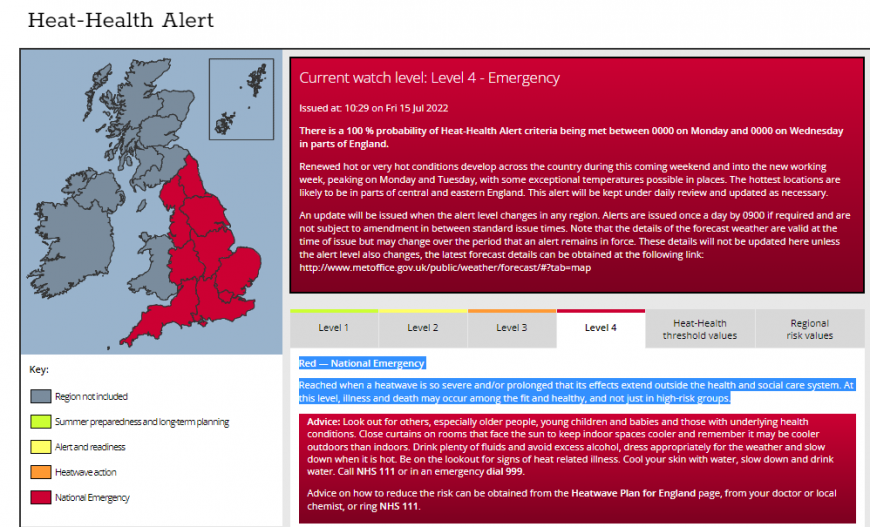
Previous Heat Health alert, before the change to the impact-based version
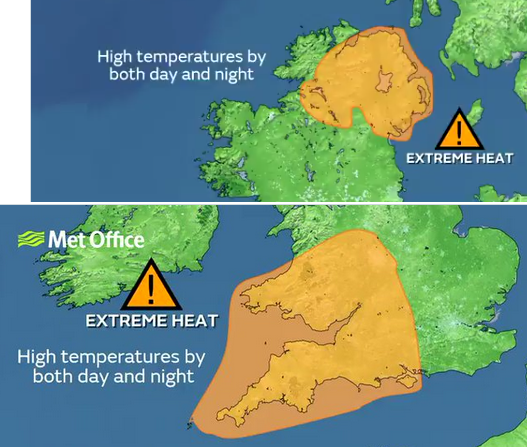
An example of the Met Office Extreme Heat warning from 2022
There isn’t a separate NSWWWS extreme cold weather warning. We rely on Ice and Snow warnings in winter which might be why the Cold Weather-Health Alerts are finding their way into mainstream weather articles.
The January 2024 amber Cold Alert used the new impact-based criteria. The Met Office flags upcoming cold weather and ice risk, and then the UKHSA adds in the health-sector resilience. Early January saw “tens of thousands of junior doctors in England begin an unprecedented 6 days of strike action” BMA along with a short spell of colder weather, the risk of ice and one day of snow in the south.
“Cold weather can increase the risks of heart attacks, strokes, and chest infections, so it can have a serious impact on health, particularly for older people and those with pre-existing health conditions.”UKHSA
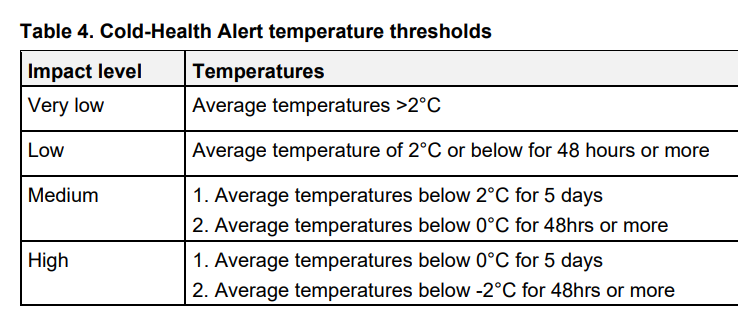
The temperature thresholds are part of the dynamic risk assessment decisions which include evidence about temperature and mortality and recent observations of how health and social care systems respond in times of severe weather. Extreme temperatures often occur when high pressure is over or near the UK. This leads to stagnant conditions with deepening cold for snow-covered areas (or increasing warm nights in summer), resulting in additional air pollution events and additional health concerns. As with the NSWWWS, other factors such as time of year, recent news and available resources, public holidays and existing media interest all feed into the overall picture
If conditions are typical of the season, the alert will be at Green. Yellow (response) relates to “Periods of heat or cold that would be unlikely to impact most people but could impact those who are particularly vulnerable”. Amber (enhanced response) “Weather impacts are likely to be felt across the whole health service, with the potential for the whole population to be at risk; non-health sectors may also start to observe impacts”. Red (emergency response) – a red alert indicates a significant risk to life for even the healthy population.
People die from the cold here in the UK. That might be from extra strain on their bodies, especially if they are elderly or already on medication. People are medicated for their usual lives, not to cope with extra stress. ONS data suggested that over 10,000 excess deaths occurred in the first quarter of 2018 which could relate to flu and the extreme cold. Other groups such as those sleeping rough will be more vulnerable. As with the current widespread flooding, ice and snow can impact hospital staff travelling to their workplaces, people attending appointments, and health workers trying to visit homes or clinics. Winter illnesses are an annual issue too and a particularly bad flu outbreak (or COVID) can hit staffing even before the severe weather arrives.
ICE - Many councils and Highways Agencies take specialised forecasts for their winter road treatments. The risk of ice often results in a widespread warning but very localised danger. There are decisions to be made about where is gritted or salted which have to be balanced against time, cost and the weather. An early morning rain shower can wash away a covering of grit and then freeze resulting in chaos for that route. Ice also puts extra pressure on Accident and Emergency services as people, particularly the elderly, fall and break bones.
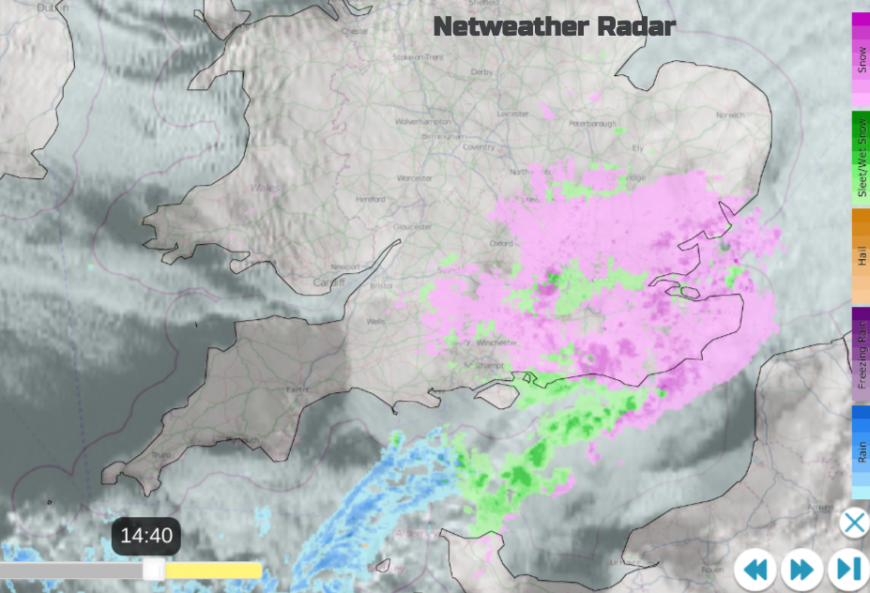
Patchy light snow over SE Britain on Jan 8th 2024
An ice warning may also refer to snow showers, or wintry precipitation within the text or there can be a dual warning of Ice and Snow.
Occasionally an ice warning can refer to the risk of freezing rain. This is a significant hazard that doesn’t occur very often in this country. When certain conditions exist in the atmosphere with a slight warming layer, cold rain hits very cold surfaces and freezes immediately. It is clear, unlike white hoar frost and very dangerous as hard to see on roads and pavements. The widespread formation of black ice would result in high impact showing on the warning matrix. It could lead to icing on power lines and outages, travel disruption and additional strain on the emergency services.
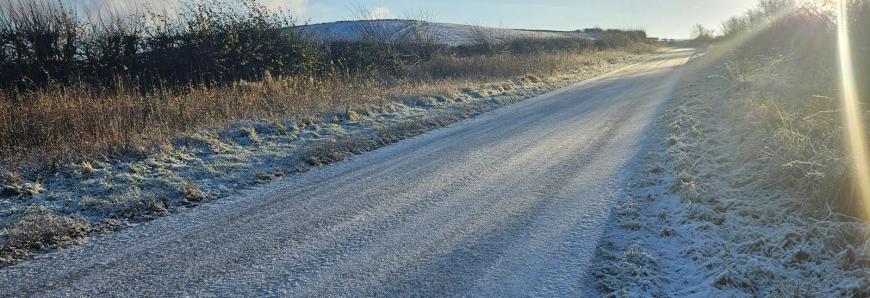
Dual warnings - A storm may bring wind and rain. In winter, we often experience snow and ice. The Met. Office can issue one dual warning which covers two types of severe weather
“The combined effect of the two weather types is used to assess the level of impact forecast. Each dual warning has a single assessment of impact and the likelihood of impacts occurring and therefore a single colour.”
Here in the UK, we are not robust when it starts to snow. There is the initial excitement as large flakes swirl about and then it doesn’t take much for road, air and rail services to grind to a halt. Compared to other European countries the impacts here seem high as soon as the snow begins. Gritting, ploughing and de-icing can help but television news services are just waiting for a queue of stranded motorists with tales of their night stuck on a motorway or A road. Anyone who dreams of heading to the Scottish mountains to ski or snowboard in winter will know that too often strong winds accompany snowfall here and this leads to drifting, blizzard conditions and difficulties keeping routes open.
It is also tricky forecasting snow here in the UK as conditions are often borderline between rain and snow. This only adds to the usual timing and location uncertainties from incoming low pressures or showers. Very occasionally, we see a sturdy easterly flow set in, where deep cold heads across the North Sea from the continent and significant snowfall is very likely. A true “Beast from the East” setup follows several significant steps. These take time to develop through the atmosphere. As they fall into place, as happened in 2018, there will be several days, even a week’s warning time before disruptive snow hits. As always you need to make sure you are relying on trusted sources, not those who declare extreme weather every other day, (see below).

For the general public, there will be warnings of ice, snow maybe freezing fog in the next few months. The Cold Health Alerts are different, aiming to guide the allocation of resources during a response to severe cold or heat. For individuals, it is worth remembering to look at the Feels Like temperature alongside the air Temperature fields in the 7-day forecast. Adding on chilly winds in winter can make a huge difference out there.
Climate Change: Health effects in the UK
Will it Snow?
Loading recent activity...